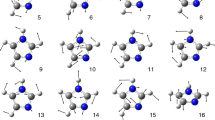Summary
Divalent cobalt, nickel, copper, zinc, cadmium and mercury salts react with 4-benzamido-1-diacetylmonoxime-3-thiosemicarbazone (BDTS) forming two types of complexes,i.e., [M(BDTS)X2 · nH2O]YH2O (M = CoII, NiII, ZnII, CdII or HgII; X = Cl, Br or 1/2 SO4 and n=0–1) and [Cu(BDTS)X]2 · nH2O (X=Cl, Br or 1/2 SO4 and n=0–1). The complexes were identified and characterized on the basis of partial chemical analysis, molar conductance, magnetic moment and spectral (visible, n.m.r., i.r.) studies. I.r. spectral studies suggest that BDTS is tridentate and coordinatesvia the azomethine groups (hydrazone and oxime residue) as well as the thioketo-group with cobalt and nickel but is bidentate coordinatingvia the azomethine groups with the remaining metal ions. Further, the ligand behaves as a reducing agent towards CuII salts forming diamagnetic CuI complexes.
Similar content being viewed by others
References
M. M. Mostafa, S. M. Hassan and G. M. Ibrahim,J. Inorg. Nucl. Chem., 42, 285 (1980).
M. M. Mostafa, M. A. Khattab and K. M. Ahmed,Polyhedron, in press.
W. J. Geary,Coord. Chem. Rev., 7, 81 (1971).
F. Senti and D. Harker,J. Am. Chem, Soc., 62, 2008 (1940).
D. Hall,Acta Crystallogr., 18, 955 (1965).
D. N. Sathyanarayana and D. Nicholls,Spectrochim. Acta, 34A, 263 (1978).
C. N. R. Rao and R. Venkataraghavan,Spectrochim. Acta, 18, 541 (1962).
N. Nakamoto,Infrared Spectra of Inorganic and Coordination Compounds, 3rd Edit., Wiley, Interscience, New York, 1978, p. 239.
F. A. Cotton and G. Wilkinson,Advanced Inorganic Chemistry. A Comprehensive Text, 4th Edit. Interscience, New York, 1980, p. 770.
C. K. Jørgensen,Acta Chim. Scand., 10, 887 (1956).
A. B. P. Lever,Inorganic Electronic Spectroscopy, Elsevier. Amsterdam, 1968, p. 341.
A. I. Vogel,Quantitative Inorganic Analysis, Longmans, Green-London, (1961).
J. Lewis and R. G. Wilkins,Modern Coordination Chemistry, Interscience, New York, (1960), p. 403.
Author information
Authors and Affiliations
Rights and permissions
About this article
Cite this article
Mostafa, M.M., El-Asmy, A.A. & Ibrahim, G.M. New metal complexes derived from 4-benzamido-1-diacetylmonoxime-3-thiosemicarbazone with some transition metal ions. Transition Met Chem 8, 54–56 (1983). https://doi.org/10.1007/BF00618800
Received:
Issue Date:
DOI: https://doi.org/10.1007/BF00618800




